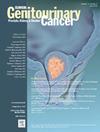Risk Stratification for the Prognosis of Patients With pT3aN0M0 Clear Cell Renal Cell Carcinoma
IF 2.7
3区 医学
Q3 ONCOLOGY
引用次数: 0
Abstract
Background
Predicting postoperative recurrence in patients with pathological T3aN0M0 clear cell renal cell carcinoma (pT3a ccRCC) is important to identify patients suitable for adjuvant immunotherapy. This study aimed to develop a novel predictive model for postoperative recurrence of pT3a ccRCC.
Materials and Methods
Patients diagnosed with pT3a ccRCC between 2010 and 2022 were retrospectively enrolled from 19 institutions. Multivariable Cox proportional hazards regression was used to identify clinical factors associated with poor disease-free survival (DFS). A risk model was established based on the hazard ratios of the identified factors. DFS and overall survival were calculated using the Kaplan-Meier method according to the risk group. The association between the risk model categories and the International Metastatic RCC Database Consortium (IMDC) score at recurrence was also evaluated using the chi-square test.
Results
This study included 541 patients with pT3a ccRCC. With a median follow-up of 46 months, postoperative recurrence occurred in 165 (30.5%) patients and death occurred in 81 (15.0%) patients. Multivariate analysis identified 6 variables associated with shorter DFS: male sex, ≥3 extrarenal tumor extension patterns, tumor size >70 mm, nuclear grade 3 or 4, sarcomatoid differentiation, and C-reactive protein ≥1.0 mg/L. The predictive model classified patients into low-, intermediate-, and high-risk categories, with 5-year DFS rates of 88%, 67%, and 39%, respectively. The area under the curve for the 5-year DFS was 0.752. At recurrence, half of the patients in the low-risk group were classified in the IMDC-favorable group, compared to 23.1% in the high-risk group.
Conclusions
This risk model can predict postoperative recurrence risk in patients with pT3a ccRCC. This model may help in selecting candidates for adjuvant therapy for pT3aN0M0 ccRCC.
pT3aN0M0透明细胞肾细胞癌患者预后的风险分层
背景:预测病理性T3aN0M0透明细胞肾细胞癌(pT3a ccRCC)患者术后复发对于确定适合进行辅助免疫治疗的患者具有重要意义。本研究旨在建立一种新的预测pT3a ccRCC术后复发的模型。材料和方法:2010年至2022年间,回顾性纳入19家机构诊断为pT3a ccRCC的患者。采用多变量Cox比例风险回归来确定与低无病生存期(DFS)相关的临床因素。根据所识别因素的风险比建立风险模型。根据风险组采用Kaplan-Meier法计算DFS和总生存期。风险模型类别与国际转移性RCC数据库联盟(IMDC)复发评分之间的关联也使用卡方检验进行评估。结果:本研究纳入541例pT3a型ccRCC患者。中位随访46个月,术后复发165例(30.5%),死亡81例(15.0%)。多因素分析确定了6个与较短DFS相关的变量:男性、≥3种肾外肿瘤扩展模式、肿瘤大小> ~ 70mm、核3级或4级、类肉瘤分化、c反应蛋白≥1.0 mg/L。该预测模型将患者分为低、中、高风险三类,5年DFS分别为88%、67%和39%。5年DFS曲线下面积为0.752。复发时,低危组中有一半的患者被归为imdc有利组,而高危组中这一比例为23.1%。结论:该风险模型可预测pT3a型ccRCC患者术后复发风险。该模型可能有助于选择pT3aN0M0型ccRCC辅助治疗的候选药物。
本文章由计算机程序翻译,如有差异,请以英文原文为准。
求助全文
约1分钟内获得全文
求助全文
来源期刊

Clinical genitourinary cancer
医学-泌尿学与肾脏学
CiteScore
5.20
自引率
6.20%
发文量
201
审稿时长
54 days
期刊介绍:
Clinical Genitourinary Cancer is a peer-reviewed journal that publishes original articles describing various aspects of clinical and translational research in genitourinary cancers. Clinical Genitourinary Cancer is devoted to articles on detection, diagnosis, prevention, and treatment of genitourinary cancers. The main emphasis is on recent scientific developments in all areas related to genitourinary malignancies. Specific areas of interest include clinical research and mechanistic approaches; drug sensitivity and resistance; gene and antisense therapy; pathology, markers, and prognostic indicators; chemoprevention strategies; multimodality therapy; and integration of various approaches.
 求助内容:
求助内容: 应助结果提醒方式:
应助结果提醒方式:


